Midwestern United States
Midwestern United States
The Midwest, American Midwest | |
|---|---|
|
Left-right from top: 2020) | |
| • Total | 68,985,454 |
| Demonym | Midwesterner |
The Midwestern United States, also referred to as the Midwest or the American Midwest, is one of four census regions of the United States Census Bureau. It occupies the northern central part of the United States.[1] It was officially named the North Central Region by the U.S. Census Bureau until 1984.[2] It is between the Northeastern United States and the Western United States, with Canada to the north and the Southern United States to the south.
The U.S. Census Bureau's definition consists of 12 states in the north central United States:
Etymology
The term West was applied to the region in British North America and in the early years of the United States, when the colonial territories had not extended far from the Atlantic coast and the Pacific seaboard was generally unknown. By the early 19th century, anything west of the Appalachia was considered American frontier. Over time the American frontier moved to west of the Mississippi River. During the colonial period, the upper-Mississippi watershed including the valleys of the Missouri River and the Illinois River, which were settled in the 17th and 18th century and called Illinois Country.[5] In 1787 the Northwest Ordinance was enacted, creating the Northwest Territory, which was bounded by the Great Lakes and the Ohio and Mississippi Rivers.[6] Some entities in the Midwest have "Northwest" in their names for historical reasons, such as Northwestern University in Illinois.[7]
One of the earliest late-19th-century uses of Midwest was in reference to Kansas and Nebraska to indicate that they were the civilized areas of the west.[8] A source in the 1920s referred to the Midwest included within this territory West Virginia, Kentucky, Tennessee, Missouri, Kansas, and Arkansas.[9] Another term applied to the same region is Heartland.[10]
The region's economy is a mix of heavy industry and agriculture, with extensive areas forming part of the United States' Corn Belt. Finance and services such as medicine and education are becoming increasingly important. Its central location makes it a transportation crossroads for river boats, railroads, autos, trucks, and airplanes. Politically, the region is composed of swing states, and therefore is heavily contested and often decisive in elections.[11][12]
Following the sociological Middletown studies of 1929, which were based on Muncie, Indiana,[13] commentators took Midwestern cities and the Midwest generally to be "typical" of the United States. Earlier, the rhetorical question Will it play in Peoria? had become a stock phrase, using Peoria, Illinois to signal whether something would appeal to mainstream America.[14] As of 2010 the Midwest has a higher employment-to-population ratio than the Northeastern United States, the Southern United States, or the Western United States.[15]
Prehistory
Precolumbian
Among the Native Americans, Paleo-Americans cultures were the earliest in North America, with a presence in the Great Plains and Great Lakes areas from about 12,000 BCE to around 8,000 BCE.[16]
Following the Paleo-American period is the
Mississippian peoples in the Midwest were mostly farmers who followed the rich, flat floodplains of Midwestern rivers. They brought with them a well-developed agricultural complex based on three major crops—
The Mississippi period was characterized by a
Great Lakes Native Americans
The major tribes of the Great Lakes region included the
Most are of the
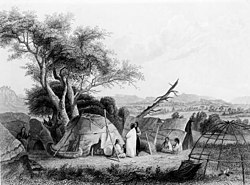
In the 16th century, the natives of the area used projectiles and tools of stone, bone, and wood to hunt and farm. They made canoes for fishing. Most of them lived in oval or conical wigwams that could be easily moved away. Various tribes had different ways of living. The Ojibwas were primarily hunters and fishing was also important in the Ojibwas economy. Other tribes such as Sac, Fox, and Miami, both hunted and farmed.[22]
They were oriented toward the open prairies where they engaged in communal hunts for
The religious beliefs varied among tribes. Hurons believed in Yoscaha, a supernatural being who lived in the sky and was believed to have created the world and the Huron people. At death, Hurons thought the soul left the body to live in a village in the sky. Chippewas were a deeply religious people who believed in the Great Spirit. They worshiped the Great Spirit through all their seasonal activities, and viewed religion as a private matter: Each person's relation with his personal guardian spirit was part of his thinking every day of life. Ottawa and Potawatomi people had very similar religious beliefs to those of the Chippewas.[17]
In the Ohio River Valley, the dominant food supply was not hunting but agriculture. There were orchards and fields of crops that were maintained by indigenous women. Corn was their most important crop.[25]
Great Plains Indians
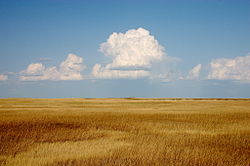
The Plains Indians are the indigenous peoples who live on the plains and rolling hills of the Great Plains of North America. Their colorful equestrian culture and famous conflicts with settlers and the US Army have made the Plains Indians archetypical in literature and art for American Indians everywhere.[citation needed]
Plains Indians are usually divided into two broad classifications, with some degree of overlap. The first group were fully nomadic, following the vast herds of
The second group of Plains Indians (sometimes referred to as Prairie Indians) were the semi-sedentary tribes who, in addition to hunting buffalo, lived in villages and raised crops. These included the
The nomadic tribes of the Great Plains survived on hunting; some of their major hunts centered on deer and buffalo. Some tribes are described as part of the "Buffalo Culture" (sometimes called, for the American bison). Although the Plains Indians hunted other animals, such as elk or antelope, bison was their primary game food source. Bison flesh, hide, and bones from bison hunting provided the chief source of raw materials for items that Plains Indians made, including food, cups, decorations, crafting tools, knives, and clothing.[citation needed][27][28]
The tribes followed the bison's seasonal grazing and migration. The Plains Indians lived in
Among the most powerful and dominant tribes were the
The Sioux comprise three major divisions based on Siouan dialect and subculture:[citation needed]
- Isáŋyathi or Isáŋathi ("Knife"): residing in the extreme east of the Dakotas, Minnesota and northern Iowa, and are often referred to as the Santee or Eastern Dakota.
- Iháŋktȟuŋwaŋ and Iháŋktȟuŋwaŋna ("Village-at-the-end" and "little village-at-the-end"): residing in the Minnesota River area, they are considered the middle Sioux, and are often referred to as the Yankton and the Yanktonai, or, collectively, as the Wičhíyena (endonym) or the Western Dakota (and have been erroneously classified as Nakota[32]).
- Thítȟuŋwaŋ or Teton (uncertain): the westernmost Sioux, known for their hunting and warrior culture, are often referred to as the Lakota.
Today, the Sioux maintain many separate tribal governments scattered across several reservations, communities, and reserves in the Dakotas, Nebraska, Minnesota, and Montana in the United States, as well as Manitoba and southern Saskatchewan in Canada.[citation needed]
History
European exploration and early settlement
The Middle Ground theory
The theory of the middle ground was introduced in Richard White's seminal work: The Middle Ground: Indians, Empires, and Republics in the Great Lakes Region, 1650–1815 originally published in 1991. White defines the middle ground like so:
The middle ground is the place in between cultures, peoples, and in between empires and the non state world of villages. It is a place where many of the North American subjects and allies of empires lived. It is the area between the historical foreground of European invasion and occupation and the background of Indian defeat and retreat.
— Richard White, The Middle Ground: Indians, Empires, and Republics in the Great Lakes Region, 1650–1815, p. XXVI
White specifically designates "the lands bordering the rivers flowing into the northern Great Lakes and the lands south of the lakes to the Ohio" as the location of the middle ground.[33] This includes the modern Midwestern states of Ohio, Indiana, Illinois, Wisconsin, and Michigan as well as parts of Canada.
The middle ground was formed on the foundations of mutual accommodation and common meanings established between the French and the Indians that then transformed and degraded as both were steadily lost as the French ceded their influence in the region in the aftermath of their defeat in the Seven Years' War and the Louisiana Purchase.[34]
Major aspects of the middle ground include blended culture, the fur trade, Native alliances with both the French and British, conflicts and treaties with the United States both during the Revolutionary War and after,[35][36] and its ultimate clearing/erasure throughout the nineteenth century.[37]
New France
European settlement of the area began in the 17th century following French exploration of the region and became known as
Mapping of the Mississippi River

In 1673 the
Marquette and Jolliet were the first to map the northern portion of the Mississippi River. They confirmed that it was easy to travel from the St. Lawrence River through the Great Lakes all the way to the Gulf of Mexico by water, that the native peoples who lived along the route were generally friendly, and that the natural resources of the lands in between were extraordinary. New France officials led by LaSalle followed up and erected a 4,000-mile (6,400 km) network of fur trading posts.[40]
Fur trade

The fur trade was an integral part of early European and Indian relations. It was the foundation upon which their interactions were built and was a system that would evolve over time.
Goods often traded included guns, clothing, blankets, strouds, cloth, tobacco, silver, and alcohol.[41][42]
France
The French and Indian exchange of goods was called an exchange of gifts rather than a trade. These gifts held greater meaning to the relationship between the two than a simple economic exchange because the trade itself was inseparable from the social relations it fostered and the alliance it created.[43] In the meshed French and Algonquian system of trade, the Algonquian familial metaphor of a father and his children shaped the political relationship between the French and the Natives in this region. The French, regarded as the metaphoric father, were expected to provide for the needs of the Algonquians and, in return, the Algonquians, the metaphoric children, would be obligated to assist and obey them. Traders coming into Indian villages facilitated this system of symbolic exchange to establish or maintain alliances and friendships.[44]
Marriage also became an important aspect of the trade in both the Ohio River valley and the French pays d'en haut with the temporary closing of the French fur trade from 1690 to 1716 and beyond.[45][46] French fur traders were forced to abandon most posts and those remaining in the region became illegal traders who potentially sought these marriages to secure their safety.[45][47] Another benefit for French traders marrying Indian women was that the Indian women were in charge of the processing of the pelts necessary to the fur trade.[48] Women were integral to the fur trade and their contributions were lauded, so much so that the absence of the involvement of an Indian Woman was once cited as the cause for a trader's failure.[49] When the French fur trade re-opened in 1716 upon the discovery that their overstock of pelts had been ruined, legal French traders continued to marry Indian women and remain in their villages.[50] With the growing influence of women in the fur trade also came the increasing demand of cloth which very quickly grew to be the most desired trade good.[51]
Britain
English traders entered the Ohio country as a serious competitor to the French in the fur trade around the 1690s.[52] English (and later British) traders almost consistently offered the Indians better goods and better rates than the French, with the Indians being able to play that to their advantage, thrusting the French and the British into competition with each other to their own benefit.[52][53] The Indian demand for certain kinds of cloth in particular fueled this competition.[54] This, however, changed following the Seven Years' War with Britain's victory over France and the cession of New France to Great Britain.[55]
The British attempted to establish a more assertive relationship with the Indians of the pays d'en haut, eliminating the practise of gift giving which they now saw as unnecessary.[55] This, in combination with an underwhelming trade relationship with a surplus of whiskey, increase in prices generally, and a shortage of other goods led to unrest among the Indians that was exacerbated by the decision to significantly reduce the amount of rum being traded, a product that British merchants had been including in the trade for years. This would eventually culminate in Pontiac's War, which broke out in 1763.[56] Following the conflict, the British government was forced to compromise and loosely re-created a trade system that was an echo of the French one.[57]
American settlement
While French control ended in 1763 after their defeat in the Seven Years' War, most of the several hundred French settlers in small villages along the Mississippi River and its tributaries remained, and were not disturbed by the new British administration. By the terms of the Treaty of Paris, Spain was given Louisiana; the area west of the Mississippi. St. Louis and Ste. Genevieve in Missouri were the main towns, but there was little new settlement. France regained Louisiana from Spain in exchange for Tuscany by the terms of the Treaty of San Ildefonso in 1800. Napoleon had lost interest in re-establishing a French colonial empire in North America following the Haitian Revolution and together with the fact that France could not effectively defend Louisiana from a possible British attack, he sold the territory to the United States in the Louisiana Purchase of 1803. Meanwhile, the British maintained forts and trading posts in U.S. territory, refusing to give them up until 1796 by the Jay Treaty.[58] American settlement began either via routes over the Appalachian Mountains or through the waterways of the Great Lakes. Fort Pitt (now Pittsburgh) at the source of the Ohio River became the main base for settlers moving into the Midwest. Marietta, Ohio in 1787 became the first settlement in Ohio, but not until the defeat of Native American tribes at the Battle of Fallen Timbers in 1794 was large-scale settlement possible. Large numbers also came north from Kentucky into southern Ohio, Indiana and Illinois.[59]
The region's fertile soil produced corn and vegetables; most farmers were self-sufficient. They cut trees and claimed the land, then sold it to newcomers and then moved further west to repeat the process.[60]
Squatters

Settlers without legal claims, called "squatters", had been moving into the Midwest for years before 1776. They pushed further and further down the Ohio River during the 1760s and 1770s and sometimes engaged in conflict with the Native Americans.[61][62] British officials were outraged. These squatters were characterized by British General Thomas Gage as "too Numerous, too Lawless, and Licentious ever to be restrained", and regarded them as "almost out of Reach of Law and government; Neither the Endeavors of Government, or Fear of Indians has kept them properly within Bounds."[63] The British had a long-standing goal of establishing a Native American buffer state in the American Midwest to resist American westward expansion.[64][65]
With victory in the American Revolution the new government considered evicting the squatters from areas that were now federally owned public lands.[66] In 1785, soldiers under General Josiah Harmar were sent into the Ohio country to destroy the crops and burn down the homes of any squatters they found living there. But overall the federal policy was to move Indians to western lands (such as the Indian Territory in modern Oklahoma) and allow a very large numbers of farmers to replace a small number of hunters. Congress repeatedly debated how to legalize settlements. On the one hand, Whigs such as Henry Clay wanted the government to get maximum revenue and also wanted stable middle-class law-abiding settlements of the sort that supported towns (and bankers). Jacksonian Democrats such as Thomas Hart Benton wanted the support of poor farmers, who reproduced rapidly, had little cash, and were eager to acquire cheap land in the West. Democrats did not want a big government, and keeping revenues low helped that cause. Democrats avoided words like "squatter" and regarded "actual settlers" as those who gained title to land, settled on it, and then improved upon it by building a house, clearing the ground, and planting crops. A number of means facilitated the legal settlement of the territories in the Midwest: land speculation, federal public land auctions, bounty land grants in lieu of pay to military veterans, and, later, preemption rights for squatters. The "squatters" became "pioneers" and were increasingly able to purchase the lands on which they had settled for the minimum price thanks to various preemption acts and laws passed throughout the 1810s-1840s. In Washington, Jacksonian Democrats favored squatter rights while banker-oriented Whigs were opposed; the Democrats prevailed.[67][68][69][70]
Native American wars
In 1791, General
The British demanded the establishment of a Native American barrier state at the Treaty of Ghent which ended the War of 1812, but American negotiators rejected the idea because Britain had lost control of the region in the Battle of Lake Erie and the Battle of the Thames in 1813, where Tecumseh was killed by U.S. forces. The British then abandoned their Native American allies south of the lakes. The Native Americans ended being the main losers in the War of 1812. Apart from the short Black Hawk War of 1832, the days of Native American warfare east of the Mississippi River had ended.[74]
Lewis and Clark

In 1803, President Thomas Jefferson commissioned the Lewis and Clark Expedition that took place between May 1804 and September 1806. Launching from Camp Dubois in Illinois, the goal was to explore the Louisiana Purchase, and establish trade and U.S. sovereignty over the native peoples along the Missouri River. The Lewis and Clark Expedition established relations with more than two dozen indigenous nations west of the Missouri River.[75] The Expedition returned east to St. Louis in the spring of 1806.
Party politics
The Midwest has been a key swing district in national elections, with highly contested elections in closely divided states often deciding the national result. From 1860 to 1920, both parties tried to find their presidential and vice presidential candidates from the region.[76]
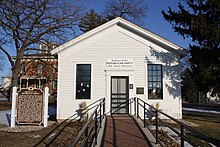
One of the two major political parties in the United States, the Republican Party, originated in the Midwest in the 1850s; Ripon, Wisconsin, had the first local meeting while Jackson, Michigan, had the first statewide meeting of the new party. Its membership included many Yankees out of New England and New York who had settled the upper Midwest. The party opposed the expansion of slavery and stressed the Protestant ideals of thrift, a hard work ethic, self-reliance, democratic decision making, and religious tolerance.[77]
In the early 1890s, the wheat-growing regions were strongholds of the short-lived Populist movement in the Plains states.[78]
Starting in the 1890s, the middle class urban
Theodore Roosevelt's
The Midwest—especially the areas west of Chicago—has always been a stronghold of
Yankees and ethnocultural politics
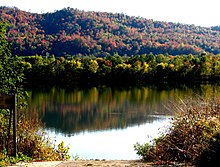
Yankee settlers from New England started arriving in Ohio before 1800, and spread throughout the northern half of the Midwest. Most of them started as farmers, but later the larger proportion moved to towns and cities as entrepreneurs, businessmen, and urban professionals. Since its beginnings in the 1830s, Chicago has grown to dominate the Midwestern metropolis landscape for over a century.[84]
Historian John Bunker has examined the worldview of the Yankee settlers in the Midwest:
Because they arrived first and had a strong sense of community and mission, Yankees were able to transplant New England institutions, values, and mores, altered only by the conditions of frontier life. They established a public culture that emphasized the work ethic, the sanctity of private property, individual responsibility, faith in residential and social mobility, practicality, piety, public order and decorum, reverence for public education, activists, honest and frugal government, town meeting democracy, and he believed that there was a public interest that transcends particular and stick ambitions. Regarding themselves as the elect and just in a world rife with sin, air, and corruption, they felt a strong moral obligation to define and enforce standards of community and personal behavior....This pietistic worldview was substantially shared by British, Scandinavian, Swiss, English-Canadian and Dutch Reformed immigrants, as well as by German Protestants and many of the Forty-Eighters.[85]
Midwestern politics pitted Yankees against the German Catholics and Lutherans, who were often led by the Irish Catholics. These large groups, Buenker argues:
Generally subscribed to the work ethic, a strong sense of community, and activist government, but were less committed to economic individualism and privatism and ferociously opposed to government supervision of the personal habits. Southern and eastern European immigrants generally leaned more toward the Germanic view of things, while modernization, industrialization, and urbanization modified nearly everyone's sense of individual economic responsibility and put a premium on organization, political involvement, and education.[86][87]
Development of transportation
Waterways

Three waterways have been important to the development of the Midwest. The first and foremost was the Ohio River, which flowed into the Mississippi River. Development of the region was halted until 1795 by Spain's control of the southern part of the Mississippi and its refusal to allow the shipment of American crops down the river and into the Atlantic Ocean.[88] This was changed with the 1795 signing of Pinckney's Treaty.[88]
The second waterway is the network of routes within the Great Lakes. The opening of the
The third waterway, the Missouri River, extended water travel from the Mississippi almost to the Rocky Mountains.[citation needed]
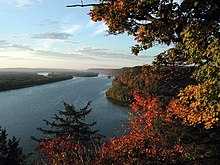
In the 1870s and 1880s, the Mississippi River inspired two classic books—Life on the Mississippi and Adventures of Huckleberry Finn—written by native Missourian Samuel Clemens, who used the pseudonym Mark Twain. His stories became staples of Midwestern lore. Twain's hometown of Hannibal, Missouri, is a tourist attraction offering a glimpse into the Midwest of his time.[citation needed]
Inland canals in Ohio and Indiana constituted another important waterway, which connected with Great Lakes and Ohio River traffic. The commodities that the Midwest funneled into the Erie Canal down the Ohio River contributed to the wealth of New York City, which overtook Boston and Philadelphia.[90]
Railroads and the automobile
During the mid-19th century, the region got its first railroads, and the railroad junction in Chicago became the world's largest. During the century, Chicago became the nation's railroad center. By 1910, over 20 railroads operated passenger service out of six different downtown terminals. Even today, a century after
In the period from 1890 to 1930, many Midwestern cities were connected by electric interurban railroads, similar to streetcars. The Midwest had more interurbans than any other region. In 1916, Ohio led all states with 2,798 miles (4,503 km), Indiana followed with 1,825 miles (2,937 km). These two states alone had almost a third of the country's interurban trackage.[93] The nation's largest interurban junction was in Indianapolis. During the decade of the early 1900s, that city's 38 percent growth in population was attributed largely to the interurban.[94]
Competition with automobiles and buses undermined the interurban and other railroad passenger business. By 1900,
In 1903, Henry Ford founded the Ford Motor Company. Ford's manufacturing—and those of automotive pioneers William C. Durant, the Dodge brothers, Packard, and Walter Chrysler—established Detroit's status in the early 20th century as the world's automotive capital. The proliferation of businesses created a synergy that also encouraged truck manufacturers such as Rapid and Grabowsky.[96]
The growth of the auto industry was reflected by changes in businesses throughout the Midwest and nation, with the development of garages to service vehicles and gas stations, as well as factories for parts and tires. Today, greater Detroit remains home to General Motors, Chrysler, and the Ford Motor Company.[97][citation needed]
American Civil War
Slavery prohibition and the Underground Railroad
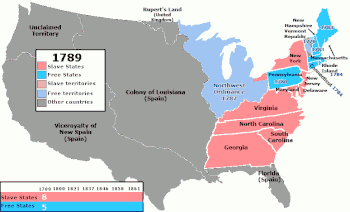
The Northwest Ordinance region, comprising the heart of the Midwest, was the first large region of the United States that prohibited slavery (the Northeastern United States emancipated slaves in the 1830s). The regional southern boundary was the Ohio River, the border of freedom and slavery in American history and literature (see Uncle Tom's Cabin by Harriet Beecher Stowe and Beloved by Toni Morrison).
The Midwest, particularly Ohio, provided the primary routes for the Underground Railroad, whereby Midwesterners assisted slaves to freedom from their crossing of the Ohio River through their departure on Lake Erie to Canada. Created in the early 19th century, the Underground Railroad was at its height between 1850 and 1860. One estimate suggests that by 1850, 100,000 slaves had escaped via the Underground Railroad.[98]
The Underground Railroad consisted of meeting points, secret routes, transportation, and safe houses and assistance provided by abolitionist sympathizers. Individuals were often organized in small, independent groups; this helped to maintain secrecy because individuals knew some connecting "stations" along the route, but knew few details of their immediate area. Escaped slaves would move north along the route from one way station to the next. Although the fugitives sometimes traveled on boat or train, they usually traveled on foot or by wagon.[99]
The region was shaped by the relative absence of slavery (except for Missouri), pioneer settlement, education in
Bleeding Kansas

The first violent conflicts leading up to the
The immediate cause of the events was the

The new
An ostensibly democratic idea, popular sovereignty stated that the inhabitants of each territory or state should decide whether it would be a free or slave state; however, this resulted in immigration en masse to Kansas by activists from both sides. At one point, Kansas had two separate governments, each with its own constitution, although only one was federally recognized. On January 29, 1861, Kansas was admitted to the Union as a free state, less than three months before the Battle of Fort Sumter officially began the Civil War.[101]
The calm in Kansas was shattered in May 1856 by two events that are often regarded as the opening shots of the Civil War. On May 21, the Free Soil town of Lawrence, Kansas, was sacked by an armed pro‐slavery force from Missouri. A few days later, the Sacking of Lawrence led abolitionist John Brown and six of his followers to execute five men along the Pottawatomie Creek in Franklin County, Kansas, in retaliation.[102]
The so-called "Border War" lasted for another four months, from May through October, between armed bands of pro‐slavery and Free Soil men. The U.S. Army had two garrisons in Kansas, the First Cavalry Regiment at
National reaction to the events in Kansas demonstrated how deeply divided the country had become. The Border Ruffians were widely applauded in the South, even though their actions had cost the lives of numerous people. In the North, the murders committed by Brown and his followers were ignored by most, and lauded by a few.[104]
The civil conflict in Kansas was a product of the political fight over slavery. Federal troops were not used to decide a political question, but they were used by successive territorial governors to pacify the territory so that the political question of slavery in Kansas could finally be decided by peaceful, legal, and political means.[citation needed]
The election of Abraham Lincoln in November 1860 was the final trigger for secession by the Southern states.[105] Efforts at compromise, including the Corwin Amendment and the Crittenden Compromise, failed. Southern leaders feared that Lincoln would stop the expansion of slavery and put it on a course toward extinction.[citation needed]
The U.S. federal government was supported by 20 mostly-Northern free states in which slavery already had been abolished, and by five slave states that became known as the border states. All of the Midwestern states but one, Missouri, banned slavery. Though most battles were fought in the South, skirmishes between Kansas and Missouri continued until culmination with the Lawrence Massacre on August 21, 1863. Also known as Quantrill's Raid, the massacre was a rebel guerrilla attack by Quantrill's Raiders, led by William Clarke Quantrill, on pro-Union Lawrence, Kansas. Quantrill's band of 448 Missouri guerrillas raided and plundered Lawrence, killing more than 150 and burning all the business buildings and most of the dwellings. Pursued by federal troops, the band escaped to Missouri.[106]
Lawrence was targeted because of the town's long-time support of abolition and its reputation as a center for
Immigration and industrialization
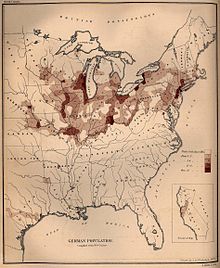
By the time of the
The U.S. was predominantly rural at the time of the Civil War. The Midwest was no exception, dotted with small farms all across the region. The late 19th century saw
A flourishing economy brought residents from rural communities and immigrants from abroad. Manufacturing and retail and finance sectors became dominant, influencing the American economy.[107]
In addition to manufacturing, printing, publishing, and food processing also play major roles in the Midwest's largest economy. Chicago was the base of commercial operations for industrialists
In the 20th century,
The
German Americans
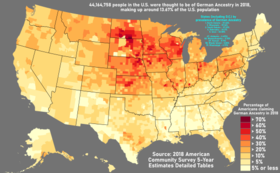
As the Midwest opened up to settlement via waterways and rail in the mid-1800s, Germans began to settle there in large numbers. The largest flow of German immigration to America occurred between 1820 and World War I, during which time nearly six million Germans immigrated to the United States. From 1840 to 1880, they were the largest group of immigrants.[110]
The Midwestern cities of
A favorite destination was Milwaukee, known as "the German Athens". Radical Germans trained in politics in the old country dominated the city's
While half of German immigrants settled in cities, the other half established farms in the Midwest. From Ohio to the Plains states, a heavy presence persists in rural areas into the 21st century.[115][116][117]
Throughout the 19th and 20th centuries, German Americans showed a high interest in becoming farmers, and keeping their children and grandchildren on the land. Western railroads, with large land grants available to attract farmers, set up agencies in
Politics 1860s–1920s
The Midwest was a battleground for political and economic issues after the Civil War, with voters splitting along ethnic and religious lines rather than class. The
Women
The presence of women in the Midwest public stage in the late 19th and early 20th centuries aligned with the growing movements for women's rights and prohibition. Women's activism was often presented as an extension of their domestic cleaning role. Activists at the local and state level used the Woman's Christian Temperance Union's crusade against alcohol, as a way to push for the right to vote. Midwestern states began allowing women to vote before the 19th Amendment was passed, and the leader of the campaign for the amendment was from Iowa. The 1970s feminist movement also had Midwestern roots, with Betty Friedan from Illinois writing The Feminine Mystique in 1963. Economic necessity and the desire for a career also drove women to work outside the home, and certain occupations such as teaching and nursing became feminized.[121]
Workers and Populists
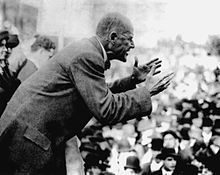
The Midwest saw labor unrest and rebellion against the capitalist economic order, with strikes in Chicago in 1887 and 1894. Labor leaders organized a protest meeting at Haymarket Square in Chicago in 1886, where a bomb was thrown among police and eight anarchists were convicted of conspiracy for murder, an event known as the Haymarket affair. The Pullman Strike of 1894 was a shutdown of most rail traffic in the Midwest and West. It turned violent and was broken by federal troops. Eugene V. Debs, leader of the striking American Railway Union, went to prison where he converted to Socialism. His version of socialism appealed to some immigrant groups but was too radical for most Midwesterners.[122]
Farmers distrusted big business and adopted cooperative arrangements, such as those offered by the
1920s
The second
Progressive Era
The negative effects of industrialization triggered the political movement of progressivism, which aimed to address its negative consequences through social reform and government regulation.
Geography

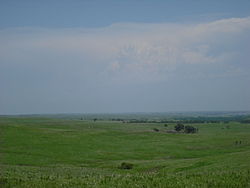
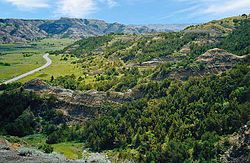

The vast central area of the U.S., into Canada, is a landscape of low, flat to rolling terrain in the
While these states are for the most part relatively flat, consisting either of plains or of rolling and small hills, there is a measure of geographical variation. In particular, the following areas exhibit a high degree of topographical variety: the eastern Midwest near the foothills of the
Proceeding westward, the
Geographers subdivide the Interior Plains into the Interior Lowlands and the Great Plains on the basis of elevation. The Lowlands are mostly below 1,500 feet (460 m) above sea level whereas the Great Plains to the west are higher, rising in Colorado to around 5,000 feet (1,500 m). The Lowlands, then, are confined to parts of Iowa, Illinois, Indiana, Ohio, Michigan, Tennessee, and Kentucky. Missouri and Arkansas have regions of Lowlands elevations, contrasting with their Ozark region (within the Interior Highlands). Eastern Ohio's hills are an extension of the Appalachian Plateau.[citation needed]
The Interior Plains are largely coincident with the vast Mississippi River Drainage System (other major components are the Missouri and Ohio Rivers). These rivers have for tens of millions of years been eroding downward into the mostly horizontal sedimentary rocks of Paleozoic, Mesozoic, and Cenozoic ages. The modern Mississippi River system has developed during the Pleistocene Epoch of the Cenozoic.[citation needed]
Rainfall decreases from east to west, resulting in different types of prairies, with the tallgrass prairie in the wetter eastern region, mixed-grass prairie in the central Great Plains, and shortgrass prairie towards the rain shadow of the Rockies. Today, these three prairie types largely correspond to the corn/soybean area, the wheat belt, and the western rangelands, respectively.[citation needed]
Much of the
Definitions

The first recorded use of the term Midwestern to refer to a region of the central U.S. occurred in 1886; Midwest appeared in 1894, and Midwesterner in 1916.[128][129] One of the earliest late-19th-century uses of Midwest was in reference to Kansas and Nebraska to indicate that they were the civilized areas of the west.[130] The term Midwestern has been in use since the 1880s to refer to portions of the central United States. A variant term, Middle West, has been used since the 19th century and remains relatively common.[131][132]
Traditional definitions of the Midwest include the Northwest Ordinance
The Midwest Region is defined by the U.S. Census Bureau as these 12 states:[1]
- Illinois: Old Northwest, Mississippi River (Missouri River joins near the state border), Ohio River, and Great Lakes state
- Indiana: Old Northwest, Ohio River, and Great Lakes state
- Iowa: Louisiana Purchase, Mississippi River, and Missouri River state
- Kansas: Louisiana Purchase, Great Plains, and Missouri River state
- Michigan: Old Northwest and Great Lakes state
- Minnesota: Old Northwest, Louisiana Purchase, Mississippi River, part of Red River Colony before 1818, Great Lakes state
- Missouri: Louisiana Purchase, Mississippi River (Ohio River joins near the state border), Missouri River, and border state
- Nebraska: Louisiana Purchase, Great Plains, and Missouri River state
- North Dakota: Louisiana Purchase, part of Red River Colony before 1818, Great Plains, and Missouri River state
- Ohio: Old Northwest (Historic Connecticut Western Reserve), Ohio River, and Great Lakes state. The southeastern part of the state is part of northern Appalachia
- South Dakota: Louisiana Purchase, Great Plains, and Missouri River state
- Wisconsin: Old Northwest, Mississippi River, and Great Lakes state
Various organizations define the Midwest with slightly different groups of states. For example, the Council of State Governments, an organization for communication and coordination among state governments, includes in its Midwest regional office eleven states from the above list, omitting Missouri, which is in the CSG South region.[134] The Midwest Region of the National Park Service consists of these twelve states plus the state of Arkansas.[135] The Midwest Archives Conference, a professional archives organization, with hundreds of archivists, curators, and information professionals as members, covers the above twelve states, plus Kentucky.[136]
| State | 2020 census | 2010 census | Change | Area | Density |
|---|---|---|---|---|---|
| 3,190,369 | 3,046,355 | +4.73% | 55,857.09 sq mi (144,669.2 km2) | 57/sq mi (22/km2) | |
| 2,937,880 | 2,853,118 | +2.97% | 81,758.65 sq mi (211,753.9 km2) | 36/sq mi (14/km2) | |
| 6,154,913 | 5,988,927 | +2.77% | 68,741.47 sq mi (178,039.6 km2) | 90/sq mi (35/km2) | |
| 1,961,504 | 1,826,341 | +7.40% | 76,824.11 sq mi (198,973.5 km2) | 26/sq mi (10/km2) | |
| 779,094 | 672,591 | +15.83% | 69,000.74 sq mi (178,711.1 km2) | 11/sq mi (4/km2) | |
| 886,667 | 814,180 | +8.90% | 75,810.94 sq mi (196,349.4 km2) | 12/sq mi (5/km2) | |
| Great Plains | 15,910,427 | 15,201,512 | +4.66% | 427,993.00 sq mi (1,108,496.8 km2) | 37/sq mi (14/km2) |
| 12,812,508 | 12,830,632 | −0.14% | 55,518.89 sq mi (143,793.3 km2) | 231/sq mi (89/km2) | |
| 6,785,528 | 6,483,802 | +4.65% | 35,826.08 sq mi (92,789.1 km2) | 189/sq mi (73/km2) | |
| 10,077,331 | 9,883,640 | +1.96% | 56,538.86 sq mi (146,435.0 km2) | 178/sq mi (69/km2) | |
| 5,706,494 | 5,303,925 | +7.59% | 79,626.68 sq mi (206,232.2 km2) | 72/sq mi (28/km2) | |
| 11,799,448 | 11,536,504 | +2.28% | 40,860.66 sq mi (105,828.6 km2) | 289/sq mi (111/km2) | |
| 5,893,718 | 5,686,986 | +3.64% | 54,157.76 sq mi (140,268.0 km2) | 109/sq mi (42/km2) | |
| Great Lakes | 53,085,258 | 51,725,489 | +2.63% | 322,528.93 sq mi (835,346.1 km2) | 165/sq mi (64/km2) |
| Total | 68,995,685 | 66,927,001 | +3.09% | 750,521.93 sq mi (1,943,842.9 km2) | 92/sq mi (35/km2) |
Major metropolitan areas
| Rank (Midwest) |
Rank (USA) |
MSA | Population[137] | State(s) | |
|---|---|---|---|---|---|
| 1 | 3 | Chicago | 9,449,351 | Illinois Indiana Wisconsin |

|
| 2 | 14 | Detroit | 4,392,041 | Michigan | 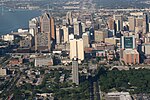
|
| 3 | 16 | Minneapolis–Saint Paul | 3,690,261 | Minnesota Wisconsin |
 
|
| 4 | 21 | St. Louis | 2,820,253 | Missouri Illinois |

|
| 5 | 30 | Cincinnati | 2,249,797 | Ohio Kentucky Indiana |

|
| 6 | 31 | Kansas City | 2,192,035 | Missouri Kansas |

|
| 7 | 32 | Cleveland |
2,185,825 | Ohio | 
|
| 8 | 33 | Columbus | 2,138,926 | Ohio | 
|
| 9 | 34 | Indianapolis | 2,089,653 | Indiana | 
|
| 10 | 40 | Milwaukee | 1,574,731 | Wisconsin | 
|
| 11 | 51 | Grand Rapids | 1,150,015 | Michigan | 
|
| 12 | 57 | Omaha | 967,604 | Nebraska Iowa |

|
| 13 | 74 | Dayton | 814,049 | Ohio | 
|
| 14 | 81 | Des Moines | 709,466 | Iowa | 
|
| 15 | 85 | Akron | 702,219 | Ohio | 
|
| 16 | 87 | Madison | 680,796 | Wisconsin | 
|
| 17 | 90 | Wichita | 647,610 | Kansas | 
|
| 18 | 96 | Toledo | 606,240 | Ohio | 
|
Economy
Farming and agriculture

The very dense soil of the Midwest plagued the first settlers who were using wooden

This development was facilitated by the
The tallgrass prairie has been converted into one of the most intensive crop producing areas in North America. Less than one tenth of one percent (<0.09%) of the original landcover of the tallgrass prairie biome remains.[145] States formerly with landcover in native tallgrass prairie such as Iowa, Illinois, Minnesota, Wisconsin, Nebraska, and Missouri have become valued for their highly productive soils.
The Corn Belt is a region of the Midwest where corn has, since the 1850s, been the predominant crop, replacing the native tall grasses. The "Corn Belt" region is defined typically to include Iowa, Illinois, Indiana, southern Michigan, western Ohio, eastern Nebraska, eastern Kansas, southern Minnesota, and parts of Missouri.[146] As of 2008[update], the top four corn-producing states were Iowa, Illinois, Nebraska, and Minnesota, together accounting for more than half of the corn grown in the United States.[147] The Corn Belt also sometimes is defined to include parts of South Dakota, North Dakota, Wisconsin, and Kentucky.[148] The region is characterized by relatively level land and deep, fertile soils, high in organic matter.[149]
Iowa produces the largest corn crop of any state. In 2012, Iowa farmers produced 18.3 percent of the nation's corn, while Illinois produced 15.3 percent.[144] In 2011, there were 13.7 million harvested acres of corn for grain, producing 2.36 billion bushels, which yielded 172.0 bu/acre, with US$14.5 billion of corn value of production.[150]
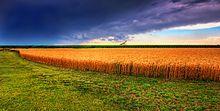
Wheat is produced throughout the Midwest and is the principal cereal grain in the country. The U.S. is ranked third in production volume of wheat, with almost 58 million tons produced in the 2012–2013 growing season, behind only China and India (the combined production of all European Union nations is larger than China)[151] The U.S. ranks first in crop export volume; almost 50 percent of total wheat produced is exported.[citation needed] The U.S. Department of Agriculture defines eight official classes of wheat: durum wheat, hard red spring wheat, hard red winter wheat, soft red winter wheat, hard white wheat, soft white wheat, unclassed wheat, and mixed wheat.[152] Winter wheat accounts for 70 to 80 percent of total production in the U.S., with the largest amounts produced in Kansas (10.8 million tons) and North Dakota (9.8 million tons). Of the total wheat produced in the country, 50 percent is exported, valued at US$9 billion.[153]
Midwestern states also lead the nation in other agricultural commodities, including
Financial
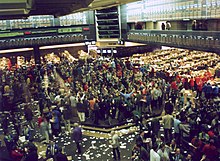
Outside of Chicago, many other Midwest cities are host to financial centers as well. Federal Reserve Bank districts are also headquartered in
Manufacturing

Navigable terrain, waterways, and ports spurred an unprecedented construction of
Advantages of accessible waterways, highly developed transportation infrastructure, finance, and a prosperous market base makes the region the global leader in automobile production and a global business location. Henry Ford's movable assembly line and integrated production set the model and standard for major car manufactures. The Detroit area emerged as the world's automotive center, with facilities throughout the region. Akron, Ohio became the global leader in rubber production, driven by the demand for tires. Over 200 million tons of cargo are shipped annually through the Great Lakes.[159][160][161]
Culture
Religion
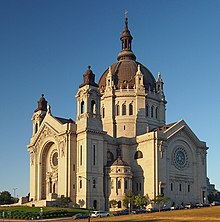
Like the rest of the United States, the Midwest is predominantly Christian.[162]
The majority of Midwesterners are
Judaism and Islam are collectively practiced by 2 percent of the population, with higher concentrations in major urban areas. 35 percent of Midwesterners attend religious services every week, and 69 percent attend at least a few times a year. People with no religious affiliation make up 22 percent of the Midwest's population.[168]
Education

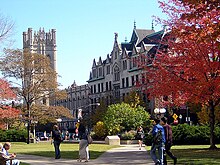
Many Midwestern universities, both public and private, are members of the
Other notable major
Numerous state university systems have established regional campuses statewide. The numerous state teachers colleges were upgraded into state universities after 1945.[172]
Other notable private institutions include the
Music

The heavy German immigration played a major role in establishing musical traditions, especially choral and orchestral music.[175] Czech and German traditions combined to sponsor the polka.[176]
The Southern Diaspora of the 20th century saw more than twenty million Southerners
The electrified Chicago blues sound exemplifies the genre, as popularized by record labels Chess and Alligator and portrayed in film The Blues Brothers.[180]

Since the founding of rock 'n' roll music, an uncountable number of rock, soul, R&B, hip-hop, dance, blues, and jazz acts have emerged from Chicago onto the global and national music scene. Detroit has greatly contributed to the international music scene as a result of being the original home of the legendary
Midwest music fans loved country music, heavy metal, arena rock, heartland rock, and TOP 40. In the 1970s and 1980s, native Midwestern musicians such as Bob Seger , John Mellencamp and Warren Zevon found great success with a style of rock music that came to be known as heartland rock, characterized by lyrical themes that focused on and appealed to the Midwestern working class. Other successful Midwestern rock artists emerged during this time, including REO Speedwagon(Illinois), Styx(Illinois), and Kansas.
Prince, The Time, Morris Day, Jesse Johnson, Alexander O'Neal, The Family(USA), St.Paul(Paul Peterson), Apollonia 6, Vanity 6, Sheila E., and Jimmy Jam and Terry Lewis recorded Minneapolis sound.[183]
Numerous
Sports
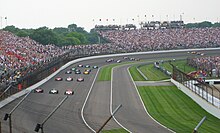
Professional sports leagues such as the National Football League (NFL), Major League Baseball (MLB), National Basketball Association (NBA), Women's National Basketball Association (WNBA), National Hockey League (NHL), Major League Soccer (MLS), and National Women's Soccer League (NWSL), have team franchises in following Midwestern cities:
- Chicago: Bears (NFL), Cubs, White Sox (MLB), Bulls (NBA), Sky (WNBA), Blackhawks (NHL), Fire FC (MLS), Red Stars (NWSL)
- Cincinnati: Bengals (NFL), Reds (MLB), FC Cincinnati (MLS)
- Cleveland: Browns (NFL), Guardians (MLB), Cavaliers (NBA)
- Crew SC(MLS)
- Detroit: Lions (NFL), Tigers (MLB), Pistons (NBA), Red Wings (NHL)
- Green Bay: Packers (NFL)
- Indianapolis: Colts (NFL), Pacers (NBA), Fever (WNBA)
- (NWSL)
- Milwaukee: Brewers (MLB), Bucks (NBA)
- Minneapolis–Saint Paul: Vikings (NFL), Twins (MLB), Timberwolves (NBA), Lynx (WNBA), Wild (NHL), United FC (MLS)
- City SC(MLS)
Popular teams include the
In NCAA college sports, the Big Ten Conference and the Big 12 Conference feature the largest concentration of top Midwestern Division I football and men's and women's basketball teams in the region, including the Cincinnati Bearcats, Illinois Fighting Illini, Indiana Hoosiers, Iowa Hawkeyes, Iowa State Cyclones, Kansas Jayhawks, Kansas State Wildcats, Michigan Wolverines, Michigan State Spartans, Minnesota Golden Gophers, Nebraska Cornhuskers, Northwestern Wildcats, Ohio State Buckeyes, Purdue Boilermakers, and the Wisconsin Badgers.[citation needed]
Other notable Midwestern college sports teams include the
The
Notable professional golf tournaments in the Midwest include the Memorial Tournament, BMW Championship and John Deere Classic.[citation needed]
Cultural overlap
This section needs additional citations for verification. (September 2011) |

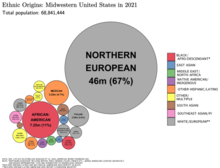
Differences in the definition of the Midwest mainly split between the Great Plains region on one side, and the Great Lakes region on the other. Although some point to the small towns and agricultural communities in Kansas, Iowa, the Dakotas, and Nebraska of the Great Plains as representative of traditional Midwestern lifestyles and values, others assert that the industrial cities of the Great Lakes—with their histories of 19th century and early 20th century immigration, manufacturing base, and strong Catholic influence—are more representative of the Midwestern experience. In South Dakota, for instance, West River (the region west of the Missouri River) shares cultural elements with the western United States, while East River has more in common with the rest of the Midwest.[186]
Two other regions,
Western Pennsylvania, which contains the cities of Erie and Pittsburgh, share history with the Midwest, but overlap with Appalachia and the Northeast as well.[187]
Kentucky is not considered part of the Midwest; it is a northern region of the South, although certain northern parts of the state could have possibly been grouped with the Midwest in a geographical context, even though it is geographically in the Southeast overall.[188] Kentucky is categorized as Southern by the U.S. Census Bureau due to its industries and especially from a historical and cultural standpoint with the majority of the state having a thoroughly majority Southern accent, demographic, history, and culture in line with her sister states of Virginia and Tennessee and even the areas that have certain Midwestern influences tend to be mixed with the native Southern culture of the area.[189][190]
In addition to intra-American regional overlaps, the
Linguistic characteristics
This section needs additional citations for verification. (September 2008) |
The accents of the region are generally distinct from those of the
The accent characteristic of most of the Midwest is popularly considered to be that of "standard" American English or
Currently, many cities in the Great Lakes region are undergoing the
The dialect of Minnesota, western Wisconsin, much of North Dakota and Michigan's Upper Peninsula is referred to as the
Missouri has elements of three dialects, specifically: Northern Midland, in the extreme northern part of the state, with a distinctive variation in St. Louis and the surrounding area; Southern Midland, in the majority of the state; and Southern, in the southwestern and southeastern parts of the state, with a bulge extending north in the central part, to include approximately the southern one-third.[194]
Health
The rate of potentially preventable hospital discharges in the Midwestern United States fell from 2005 to 2011 for overall conditions, acute conditions, and chronic conditions.[195]
Euchre
Euchre, a trick-taking card game, remains popular in the Midwest and parts of the Upper South, particularly in Michigan, Illinois, Indiana, Ohio, Kentucky, and Pennsylvania.[196]
Politics
This section needs additional citations for verification. (December 2014) |
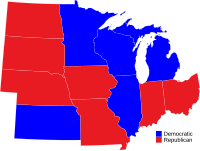
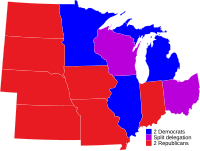
The Upper Midwestern states of Illinois, Michigan, Minnesota, and Wisconsin reliably voted Democratic in every presidential election from 1992 to 2012. Recently, Republicans have made serious inroads in Iowa and Ohio, two states that were previously considered swing states. Missouri has been won by Republicans in every presidential election since 2000, despite its
All Midwestern states use primary elections to select delegates for both the Democratic and Republican national conventions, except for Iowa. The Iowa caucuses in early January of leap years are the first votes in the presidential nominating process for both major parties, and attract enormous media attention.[199]
East North Central
As of 2023, the state government of Illinois currently has a Democratic Governor J.B. Pritzker and Democratic supermajorities in both houses of the Illinois General Assembly. Illinois also has 2 Democratic U.S. senators and a 14–3 Democratic majority U.S. House delegation.
As of 2023, Wisconsin has a Democratic Governor
Except in 2016, Michigan has consistently voted for the Democratic presidential candidate since 1992. Democrats won full control of Michigan's state government in the 2022 midterms for the first time since 1983. As of 2023, Michigan has 2 Democratic U.S. Senators and a 7-6 bare Democratic majority U.S. House of Representatives delegation.
Indiana is considered a Republican stronghold, having voting for that party's presidential candidate in every election since 1940, except for Johnson in 1964 and Barack Obama in 2008. As of 2023, the Republican party controls both U.S. Senate seats, has a 7–2 majority U.S. House congressional delegation, and has a state-level trifecta (the governorship and both houses of the Indiana General Assembly).
Ohio was historically a battleground state in presidential elections, and no Republican has won the office without winning Ohio. At the state level, however, Republicans are currently dominant with a trifecta (the governorship and both houses of the Ohio General Assembly). At the federal level, Ohio has had one Democratic and one Republican U.S. Senator since 2007. However, Donald Trump won Ohio by about 8 percentage points in both the 2016 and 2020 presidential elections, signaling a shift towards the right for the state's federal electorate. The 2022 midterms cemented Ohio's status as strongly Republican leaning at the state level and moderately Republican leaning at the federal level, with Republican governor Mike DeWine winning reelection in a landslide and Republican author J. D. Vance winning election to the U.S. Senate by about 6 percentage points.
West North Central
The Great Plains states of North Dakota, South Dakota, Nebraska, and Kansas have been strongholds for the Republicans for many decades. These four states have gone for the Republican candidate in every presidential election since 1940, except for Lyndon B. Johnson's landslide over Barry Goldwater in 1964. Although North Dakota and South Dakota have often elected Democrats to Congress, after the 2012 election both states' congressional delegations are majority Republican. Nebraska has elected Democrats to the Senate and as governor in recent years, but both of its senators have been Republican since the retirement of Ben Nelson in 2012. Kansas has elected a majority of Democrats as governor since 1956, but has not elected a Democratic senator since 1932. From 1997 to 2010 and again since 2019, Kansas has had at least one Democratic House member (two in 2007 and '08).
Iowa had a Democratic governor from 1999 until
Minnesota voters have not voted for a Republican candidate for president since 1972, longer than any other state. Minnesota was the only state (along with Washington, D.C.) to vote for its native son
Missouri was historically considered a bellwether state, having voted for the winner in every presidential election from 1904 to 2004 except for 1956, when it backed losing Democrat Adlai Stevenson. Democrats generally only hold sway in the large cities at the opposite ends of the state, Kansas City and St. Louis, with the Republicans winning the rest of the state. Since the 2012 elections, Republicans have had a 6–2 majority in the state's U.S. House delegation, with African-American Democrats representing the two major cities. Missouri has had a Republican governor since the 2016 elections, as well as both U.S. Senators being Republican since the 2018 United States Senate elections. As of 2023, Republicans have supermajorities in both houses of the Missouri General Assembly.
See also
- Cuisine of the Midwestern United States
- Repopulation of wolves in Midwestern United States
- Territories of the United States on stamps
References
- ^ a b c d e "Census Regions and Divisions of the United States" (PDF). U.S. Census Bureau. Retrieved October 24, 2016.
- ^ "History: Regions and Divisions". United States Census Bureau. Retrieved November 26, 2014.
- ISBN 978-0-495-38950-7. Retrieved June 13, 2017.
- ^ "Change in Resident Population of the 50 States, the District of Columbia, and Puerto Rico: 1910 to 2020" (PDF). Census.gov. United States Census Bureau. Archived (PDF) from the original on April 26, 2021. Retrieved April 27, 2021.
- ISBN 9780252069246.
- ^ Statistical Abstract of the United States 1995 (PDF) (Report). U.S. Bureau of the Census. 1995. Retrieved April 9, 2020.
- ^ Jay Pridmore (2000) "Northwestern University: Celebrating 150 Years" Evanston, IL: Northwestern University Press
- ^ Blaser, Kent (1990). "Of the Midwest". The Midwest Review. Wayne State College.: 69.
- ^ Online Etymology Dictionary
- ^ Merriam-Webster online
- ISBN 9781416539056.
- ISBN 9780226398259.
- ^ Sisson (2006) pp. 69–73; Richard Jensen, "The Lynds Revisited", Indiana Magazine of History (December 1979) 75: 303–319
- ^ Place Names in the Midwestern United States edited by Edward Callary published by Edwin Mellen Press 2000 ISBN 0773477233
- ^ "Bureau of Labor Statistics". Stats.bls.gov. March 4, 2010. Retrieved October 3, 2010.
- ISBN 978-0199735785. Retrieved February 26, 2015.
- ^ a b "Indian American culture in the midwest prior to the arrival of Europeans". Archived from the original on August 12, 2011. Retrieved June 17, 2011.
- ISBN 0-8173-5126-4.
- Timothy R. Pauketat, Cahokia: Ancient America's Great City on the Mississippi (2009)
- ^ Native Peoples of the Region Archived June 17, 2015, at the Wayback Machine GLIN Daily News
- ^ Great Lakes History: A General View Archived December 17, 2011, at the Wayback Machine Indian Country Wisconsin.
- ^ "Fox". Encyclopædia Britannica. Retrieved June 21, 2020.
- ISBN 9780472061075
- ^ Hyde, George E.; Indians of the Woodlands From Prehistoric Times to 1725; Norman, Oklahoma; University of Oklahoma Press; 1962.
- ^ Sleeper-Smith, Susan (2018). Indigenous Prosperity and American Conquest: Indian Women of the Ohio River Valley, 1690–1792. pp. 13–15, 29, 64–65.
- ^ Schneider, Fred "Prehistoric Horticulture in the Northeastern Plains." Plains Anthropologist, 47 (180), 2002, pp. 33-50
- ^ Moulton, M (1995). Wildlife issues in a changing world, 2nd edition. CRC Press.
- ISBN 978-0-300-12654-9.
- ^ The Sioux Indians were a Great and Powerful Tribe. Native Net: Online.
- ^ Hamalainen, 20–21
- ^ For a report on the long-established blunder of misnaming as Nakota, the Yankton and the Yanktonai, see the article Nakota
- ^ White, Richard (1991). The Middle Ground: Indians, Empires, and Republics in the Great Lakes Region, 1650–1815. pp. XXVI–XXVII.
- ^ White, Richard (1991). The Middle Ground: Indians, Empires, and Republics in the Great Lakes Region, 1650–1815. pp. XXV–XXVI.
- ^ White, Richard (1991). The Middle Ground: Indians, Empires, and Republics in the Great Lakes Region, 1650–1815.
- ^ Sleeper-Smith, Susan (2018). Indigenous Prosperity and American Conquest: Indian Women of the Ohio River Valley, 1690–1792.
- ^ Buss, James (2011). Winning the West with Words, Language and Conquest in the Lower Great Lakes.
- ^ Charles J. Balesi, The Time of the French in the Heart of North America, 1673–1818 (3d ed. 2000); W. J. Eccles, The French in North America, 1500–1783 (2nd ed. 1998)
- ^ "Marquette and Joliet". mrnussbaum.com. Archived from the original on October 3, 2011. Retrieved June 17, 2011.
- ^ "Marquette & Joliet". May 2, 2006. Archived from the original on May 2, 2006. Retrieved April 17, 2021.
- ^ White, Richard (1991). The Middle Ground: Indians, Empires, and Republics in the Great Lakes Region, 1650–1815. pp. 113.
- ^ Sleeper-Smith, Susan (2018). Indigenous Prosperity and American Conquest: Indian Women of the Ohio River Valley, 1690–1792. pp. 103, 128, 194.
- ^ White, Richard (1991). The Middle Ground: Indians, Empires, and Republics in the Great Lakes Region, 1650–1815. pp. 98–99, 1112.
- ^ White, Richard (1991). The Middle Ground: Indians, Empires, and Republics in the Great Lakes Region, 1650–1815. pp. 112.
- ^ a b White, Richard (1991). The Middle Ground: Indians, Empires, and Republics in the Great Lakes Region, 1650–1815. pp. 68.
- ^ Sleeper-Smith, Susan (2018). Indigenous Prosperity and American Conquest: Indian Women of the Ohio River Valley, 1690–1792. p. 102.
- ^ Sleeper-Smith, Susan (2018). Indigenous Prosperity and American Conquest: Indian Women of the Ohio River Valley, 1690–1792. p. 100.
- ^ Sleeper-Smith, Susan (2018). Indigenous Prosperity and American Conquest: Indian Women of the Ohio River Valley, 1690–1792. pp. 96–97.
- ^ Sleeper-Smith, Susan (2018). Indigenous Prosperity and American Conquest: Indian Women of the Ohio River Valley, 1690–1792. p. 99.
- ^ Sleeper-Smith, Susan (2018). Indigenous Prosperity and American Conquest: Indian Women of the Ohio River Valley, 1690–1792. pp. 102, 108.
- ^ Sleeper-Smith, Susan (2018). Indigenous Prosperity and American Conquest: Indian Women of the Ohio River Valley, 1690–1792. p. 167.
- ^ a b White, Richard (1991). The Middle Ground: Indians, Empires, and Republics in the Great Lakes Region, 1650–1815. pp. 119.
- ^ Sleeper-Smith, Susan (2018). Indigenous Prosperity and American Conquest: Indian Women of the Ohio River Valley, 1690–1792. pp. 117, 167–168.
- ^ Sleeper-Smith, Susan (2018). Indigenous Prosperity and American Conquest: Indian Women of the Ohio River Valley, 1690–1792. pp. 167–168.
- ^ a b White, Richard (1991). The Middle Ground: Indians, Empires, and Republics in the Great Lakes Region, 1650–1815. pp. 256.
- ^ White, Richard (1991). The Middle Ground: Indians, Empires, and Republics in the Great Lakes Region, 1650–1815. pp. 264–266, 285–289.
- ^ White, Richard (1991). The Middle Ground: Indians, Empires, and Republics in the Great Lakes Region, 1650–1815. pp. 289.
- ISBN 9781598845303.
- OCLC 2699306.
- ^ Frederick Jackson Turner, The Frontier in American History (1921) pp 271-72.
- ^ Buss, James (2011). Winning the West with Words, Language and Conquest in the Lower Great Lakes. p. 39.
- ^ White, Richard (1991). The Middle Ground: Indians, Empires, and Republics in the Great Lakes Region, 1650–1815. pp. 340–341.
- ^ White, Richard (1991). The Middle Ground: Indians, Empires, and Republics in the Great Lakes Region, 1650–1815. pp. 340.
- ^ Dwight L. Smith, "A North American Neutral Indian Zone: Persistence of a British Idea" Northwest Ohio Quarterly 1989 61(2-4)|page=46-63
- ISBN 9780802083586.
- ^ Alan Brown, "The Role of the Army in Western Settlement Josiah Harmar's Command, 1785-1790" Pennsylvania Magazine of History and Biography 93#2 pp. 161-172. online
- ^ Richard White, "It's Your Misfortune and None of My Own": A New History of the American West (U of Oklahoma Press, 1991) pp. 137-143.
- ^ On federal policy see Benjamin Horace Hibbard, A history of the public land policies (1924).
- ^ On the settlers and squatters, see Everett Dick, The Lure of the Land: A Social History of the Public Lands from the Articles of Confederation to the New Deal (U of Nebraska Press, 1970) pp 9-69.
- .
- ^ Leroy V. Eid, "American Indian Military Leadership: St. Clair's 1791 Defeat". Journal of Military History (1993) 57#1 pp. 71-88.
- ^ William O. Odo, "Destined for Defeat: an Analysis of the St. Clair Expedition of 1791". Northwest Ohio Quarterly (1993) 65#2 pp. 68-93.
- ^ John F. Winkler, Wabash 1791: St Clair's Defeat (Osprey Publishing, 2011)
- ISBN 9780806184616.
- ISBN 978-0-313-31661-6.
- ^ Gould, Lewis L. (2012). Grand Old Party: A History of the Republicans (2nd ed.). p. 126.
- ^ Gould (2012). Grand Old Party: A History of the Republicans (2nd ed.). p. 14.
- ^ John D. Hicks, "The Birth of the Populist Party". Minnesota History 9.3 (1928): 219-247.
- ^ David Thelen, Robert M. La Follette and the insurgent spirit (Univ of Wisconsin Press, 1985).
- ^ Thelen, 1985.
- JSTOR 1845783.
- S2CID 144875635.
- ISBN 978-0-87414-019-4.
- ^ "Yankees" in Reiff, ed. Encyclopedia of Chicago
- )
- ^ John Buenker, "Wisconsin"
- ^ Richard J. Jensen, Illinois: a Bicentennial history (1977) ch 1-3
- ^ OCLC 51281165.
- ^ "Saint Lawrence Seaway". Encyclopedia.com. Retrieved April 17, 2021.
- ^ "The Building of the Erie Canal". Bill of Rights Institute. Retrieved August 18, 2022.
- ^ Condit (1973), pp. 43–49, 58, 318–319.
- OCLC 45908903.
- ^ "US History Encyclopedia: Interurban Railways". Answers.com. Retrieved October 3, 2010.
- ^ David P. Morgan (ed.): The Interurban Era, Kalmbach Publishing Co., pp. 16–17.
- JSTOR 3144703.
- ^ Woodford, Arthur M. (2001). This is Detroit: 1701–2001. Wayne State University Press
- ^ "About GM | General Motors". Gm.com. Retrieved February 23, 2019.
- ^ The Fugitive Slave Law Archived January 25, 2009, at the Wayback Machine African-American History, pp. 1–2. About.com
- ^ Bordewich, Fergus, 2005, p. 236
- ^ "Springfield's 375th: From Puritans to presidents". Masslive.com. May 10, 2011. Retrieved July 16, 2017.
- ^ Robert W. Johansson, Stephen A. Douglas (Oxford UP, 1973) pp 374–400
- ^ Africans in America Resource Bank: People and Events, 1853–1861, online. Retrieved June 14, 2011.
- ^ Gale Encyclopedia of U.S. History: Pottawatomie Massacre. Answers.com. Retrieved June 14, 2011
- ^ United States History – Bleeding Kansas online. Retrieved June 14, 2011.
- ^ David Potter, The Impending Crisis, p. 485.
- S2CID 144554839. Archived from the original(PDF) on October 2, 2018.
- ^ Conzen, Michael. "Global Chicago". Encyclopedia of Chicago. Archived from the original on April 11, 2023.
- ^ a b "Modern Steel Construction" (PDF). Modern Steel Construction. American Institute of Steel Construction. 1963. Archived from the original (PDF) on March 18, 2014. Retrieved July 16, 2017.
- ^ a b "Gateway Arch". National Historic Landmarks Program. Archived from the original on August 4, 2009. Retrieved December 14, 2010.
- ^ Günter Moltmann, "The Pattern of German Emigration to the United States in the Nineteenth Century". in America and the Germans, Volume 1 (University of Pennsylvania Press, 2016) pp. 14-24.
- ^ Faust, Albert Bernhardt (1909), The German Element in the United States with Special Reference to Its Political, Moral, Social, and Educational Influence, Boston: Houghton-Mifflin
- ^ Census data from Bureau of the Census, Thirteenth census of the United States taken in the year 1910 (1913)
- ^ German Village Society, archived from the original on May 9, 2008, retrieved November 19, 2009
- ^ Trudy Knauss Paradis, et al. German Milwaukee (2006)
- ^ Conzen, Kathleen (1980), "Germans", in Thernstrom, Stephan (ed.), Harvard Encyclopedia of American Ethnic Groups, Belknap Press, p. 407
- ^ Richard Sisson, ed. The American Midwest (2007), p. 208; Gross (1996); Johnson (1951).
- ^ Kathleen Neils Conzen, Germans in Minnesota. (2003).
- Kansas Historical Quarterly28 (Autumn 1962): 310–16; cited in Turk, "Germans in Kansas", (2005) p 57.
- ^ Michael Kazin, ed. The concise Princeton Encyclopedia of American political history (2011) p 347.
- ^ Richard Jensen, The Winning of the Midwest: Social and Political Conflict, 1888-1896 (1971).
- ^ Michael Kazin, ed. The concise Princeton Encyclopedia of American political history (2011) pp. 347–348.
- ^ Nick Salvatore, Eugene V. Debs: citizen and socialist (U of Illinois Press, 1982).
- ^ Kazin, ed. The concise Princeton Encyclopedia of American political history (2011) pp. 348–349.
- ^ Kazin, ed. The concise Princeton Encyclopedia of American political history (2011) p. 349.
- ^ Allen F. Davis, "The social workers and the progressive party, 1912-1916." American Historical Review 69.3 (1964): 671-688 online.
- ^ Kazin, p. 348.
- ^ "Remote Sensing Tutorial, Section 6, online". Archived from the original on April 15, 2000. Retrieved June 9, 2011.
- ^ Oxford English Dictionary entries for Midwestern, Midwest, and Midwesterner, http://www.oed.com/
- ^ "Regional Song Sampler: The Midwest | Library of Congress". Loc.gov. Retrieved July 16, 2017.
- ^ Blaser, Kent (1990). "Of the Midwest". The Midwest Review. Wayne State College.: 69.
- ISBN 978-0-8078-4807-4.; among many others.
- ^ "About this Collection – Railroad Maps, 1828–1900 | Digital Collections | Library of Congress". Memory.loc.gov. Retrieved July 16, 2017.
- ISSN 0021-8723.
- ^ "CSG Regional Offices". Council of State Governments. 2012. Archived from the original on February 20, 2014. Retrieved February 13, 2014.
- ^ "National Parks in the Midwest | National Park Service". Nps.gov. Retrieved July 16, 2017.
- ^ "What is MAC". Midwest Archives Conference. 2012. Retrieved January 3, 2018.
- ^ "2020 Population and Housing State Data". United States Census Bureau, Population Division. August 12, 2021. Retrieved March 10, 2023.
- ISBN 978-1-4752-5845-5, p. 25
- ^ The U.S. Department of State Fact Monster. Retrieved June 2, 2011.
- ^ Edward L. Schapsmeier and Frederick H. Schapsmeier, Prophet in Politics: Henry A. Wallace and the War Years, 1940–1965 (1970) p, 234
- ^ Smith, C. Wayne., Javier Betrán, and E. C. A. Runge. Corn: Origin, History, Technology, and Production. Hoboken, NJ: John Wiley, 2004. page 4. Print
- ^ "Iowa State: 150 Points of Pride". Iowa State University. Archived from the original on June 21, 2015. Retrieved June 17, 2015.
- ^ Shurtleff, William; Aoyagi, Akiko (2004). History of World Soybean Production and Trade – Part 1. Soyfoods Center, Lafayette, California: Unpublished Manuscript, History of Soybeans and Soyfoods, 1100 B.C. to the 1980s.
- ^ a b c "Iowa State Fact Sheets". Ers.usda.gov. Retrieved June 17, 2015.
- ^ "Carl Kurtz. Iowa's Wild Places: An Exploration With Carl Kurtz (Iowa Heritage Collection) Iowa State Press; 1st edition (July 30, 1996)".
- ^ Hart (1986)
- ^ "USDA ERS – State Fact Sheets". Ers.usda.gov. Retrieved July 16, 2017.
- ^ "USDA – NASS, Census of Agriculture – 2007 Census Ag Atlas Maps". Agcensus.usda.gov. February 11, 2015. Archived from the original on October 20, 2017. Retrieved July 16, 2017.
- ^ Corn Belt, Encyclopædia Britannica Online
- ^ "Iowa Agriculture Quick Facts 2011". Iowa Department of Agriculture and Land Stewardship. Archived from the original on June 18, 2015. Retrieved June 17, 2015.
- ^ "India to Import Wheat as Stocks Remain Tight, While Exporting Ample Rice" (PDF). Apps.fas.usda.gov. Retrieved July 16, 2017.
- ^ "Subpart M -- United States Standards for Wheat" (PDF). Gipsa.usda.gov. Archived from the original (PDF) on July 19, 2021. Retrieved July 16, 2017.
- ^ "US Seeks Fast Test to Settle GM Wheat Scare". Voice of America. June 4, 2013. Retrieved June 11, 2013.
- ISSN 0362-4331. Retrieved February 24, 2020.
- ^ "London named world's top business center by MasterCard", CNN, June 13, 2007.
- ^ "Timeline-of-achievements". CME Group. Retrieved January 20, 2013.
- ^ "Futures & Options Trading for Risk Management". CME Group. April 13, 2010. Retrieved November 6, 2011.
- ^ "U.S. Steel - Primary Energy Cogeneration Plant at Gary Works Wins National Recognition". NiSource, Inc. October 14, 1999. Archived from the original on October 22, 2007. Retrieved June 10, 2011.
- ^ "About Our Great Lakes -Great Lakes Basin Facts-". NOAA Great Lakes Environmental Research Lab. Archived from the original on March 8, 2012. Retrieved May 7, 2016.
- ^ "Economy of the Great Lakes Region". Great Lakes Information Network. Archived from the original on May 4, 2012. Retrieved May 7, 2016.
- ^ "Great Lakes Navigation System: Economic Strength to the Nation" (PDF). U.S Army Corps of Engineers. January 2009. Archived from the original (PDF) on July 18, 2011. Retrieved July 27, 2010.
- ^ Sisson R., Zacher C.K., Cayton A.R.L. (2006.) The American Midwest: An Interpretic Encyclopedia, Indiana University Press, pg. 705.
- ^ Jones, Jeffrey M. (June 22, 2004). "Tracking Religious Affiliation, State by State". Gallup, Inc. Retrieved February 28, 2013.
- ^ Philip Barlow and Mark Silk, Religion and public life in the midwest: America's common denominator? (2004)
- ^ "American Religious Identification Survey 2001" (PDF). The Graduate Center of the City University of New York. Archived from the original (PDF) on May 16, 2012. Retrieved January 4, 2012.
- ^ "Ancestry in the Midwest". Statistical Atlas. Retrieved March 22, 2018.
- ^ "Southern Baptist Convention statistics". Adherents.com. Archived from the original on October 12, 1999. Retrieved October 3, 2010.
{{cite web}}: CS1 maint: unfit URL (link) - ^ "Religious Landscape Study: Adults in the Midwest". Pew Research Center. Retrieved March 22, 2018.
- )
- ^ "AAU Membership". Association of American Universities. Archived from the original on June 23, 2015. Retrieved June 16, 2015.
- ^ "Carnegie Classifications – Highest Research Doctoral". carnegieclassifications.iu.edu. April 14, 2018. Retrieved April 14, 2018.
- ISBN 978-0253003492.
- ^ Kenneth H. Wheeler, Cultivating Regionalism: Higher Education and the Making of the American Midwest (2011)
- ^ Edward Fiske, Fiske Guide to Colleges 2015 (2014)
- Philip Bohlman) and Otto Holzapfel, Land without nightingales: music in the making of German-America (German-American Cultural Society, 2002)
- JSTOR 540477.
- ^ James N. Gregory, The Southern Diaspora: How the Great Migration of Black and White Southerners Transformed America
- ^ Lars Björn, Before Motown: a history of jazz in Detroit, 1920–60 (2001).
- ^ Ross Russell, Jazz style in Kansas City and the Southwest (1983)
- ^ The Blues Brothers BFI Retrieved 18 January 2024
- ISBN 978-0-8065-2631-7.
- ^ Chuck Berry BBC Retrieved 18 January 2024
- ^ Prince and Minneapolis sound Popmatters.com Retrieved 18 January 2024
- ^ Haider, Shuja (July 13, 2017). "Letter of Recommendation: Detroit Techno". The New York Times.
- ^ "NCAA Sports Sponsorship: NCAA Sports Listing". NCAA. Retrieved June 29, 2017. To determine whether a Division I school sponsors football, and at what level, select "Football" from the "Sport" menu. In the "Division" menu, select "FBS" (for Football Bowl Subdivision) or "FCS" (for Football Championship Subdivision) as applicable. Finally, click on "Run Report".
- ISBN 978-0-89865-730-2.
- ^ "Defining the Midwest Megaregion". America 2050. December 8, 2005. Archived from the original on October 4, 2011. Retrieved July 16, 2017.
- ^ The North American Midwest: A Regional Geography. New York City: Wiley Publishers. 1955.
- ^ "Welcome to Travel South USA". Travelsouthusa.org. Archived from the original on July 20, 2010. Retrieved October 3, 2010.
- ^ "Encyclopedia – Britannica Online Encyclopedia". Britannica.com. Retrieved October 3, 2010.
- ISBN 9783110851991.
- ^ Gewertz, Ken (December 12, 2002). "Standing on line at the bubbler with a hoagie in my hand". Harvard Gazette. Retrieved August 11, 2010.
- ^ "Northern Cities Shift". Ic.arizona.edu. Archived from the original on November 20, 2005. Retrieved October 3, 2010.
- ^ Lavov, William; et al. "A National Map of the Regional Dialects of American English". Linguistics Laboratory, Department of Linguistics, University of Pennsylvania. Retrieved September 18, 2013.
- PMID 25411684.
- ^ "This Old-School Card Game is the Midwest's Best Kept Secret". Pure Wow. November 15, 2021. Retrieved September 28, 2022.
- ^ "Election Statistics, 1920 to Present". History, Art & Archives: US House of Representatives. Retrieved July 30, 2018.
- ^ "Unicam Focus". Nebraska Legislature. Retrieved July 30, 2018.
- Caroline J. Tolbert, and Todd Donovan, Why Iowa?: how caucuses and sequential elections improve the presidential nominating process (2011)
- ^ Leip, David. "Dave Leip's Atlas of U.S. Presidential Elections". uselectionatlas.org. Retrieved February 15, 2016.
Further reading
- Aley, Ginette et al. eds. Union Heartland: The Midwestern Home Front during the Civil War (2013)
- Barlow, Philip, and Mark Silk. Religion and Public Life in the Midwest: America's Common Denominator? (2004)
- Billington, Ray Allen. "The Origins of Middle Western Isolationism". Political Science Quarterly (1945): 44–64. in JSTOR
- Buley, R. Carlyle. The Old Northwest: Pioneer Period 1815–1840 2 vol (1951), Pulitzer Prize; online
- Buss, James Joseph. Winning the West with Words, Language and Conquest in the Lower Great Lakes (University of Oklahoma Press, 2011)
- Cayton, Andrew R. L. Midwest and the Nation (1990)
- Cayton, Andrew R. L. and Susan E. Gray, Eds. The Identity of the American Midwest: Essays on Regional History (2001)
- Condit, Carl W. (1973). The Chicago School of Architecture: A History of Commercial and Public Building in the Chicago Area, 1875–1925. Chicago: University of Chicago Press. OCLC 1112620.
- Cordier, Mary Hurlbut. Schoolwomen of the Prairies and Plains: Personal Narratives from Iowa, Kansas, and Nebraska, 1860s-1920s (1997) online
- Cronon, William. Nature's Metropolis: Chicago and the Great West (1992), 1850–1900 excerpt and text search
- Fry, John. "Good Farming – Clear Thinking – Right Living": Midwestern Farm Newspapers, Social Reform, and Rural Readers in the Early Twentieth Century". Agricultural History 78#1 ( 2004): 34–49.
- Garland, John H. The North American Midwest: A Regional Geography (1955)
- Gjerde, John. Minds of the West: Ethnocultural Evolution in the Rural Middle West, 1830–1917 (1999) excerpt and text search
- High, Stephen C. Industrial Sunset: The Making of North America's Rust Belt, 1969–1984 (Toronto, 2003)
- Hoganson, Kristin L. The Heartland: An American History (Penguin Random House, 2019) online reviews
- Jensen, Richard. The Winning of the Midwest: Social and Political Conflict, 1888–1896 (1971) online
- Jordan, Philip D.Ohio Comes of Age: 1873–1900 Volume 5 (1968) online
- Lauck, Jon K. The Good Country: A History of the American Midwest, 1800–1900 (2022) excerpt
- Lauck, Jon K. "Trump and The Midwest: The 2016 Presidential Election and The Avenues of Midwestern Historiography" Studies in Midwestern History (2017) vol 3#1 online
- Lauck, Jon K. and Catherine McNicol Stock, eds. The Conservative Heartland: A Political History of the Postwar American Midwest (UP of Kansas, 2020) online review
- Longworth, Richard C. Caught in the Middle: America's Heartland in the Age of Globalism (2008)
- Meyer, David R. "Midwestern Industrialization and the American Manufacturing Belt in the Nineteenth Century", The Journal of Economic History, Vol. 49, No. 4 (December 1989) pp. 921–937.in JSTOR
- Nelson, Daniel. Farm and Factory: Workers in the Midwest 1880–1990 (1995),
- Nordin, Dennis S., and Roy V. Scott. From Prairie Farmer to Entrepreneur: The Transformation of Midwestern Agriculture. (2005) 356pp.
- Nye, Russel B. Midwestern Progressive Politics (1959) online
- Page, Brian, and Richard Walker. "From settlement to Fordism: the agro-industrial revolution in the American Midwest". Economic Geography (1991): 281–315. in JSTOR
- Scheiber, Harry N. ed. The Old Northwest; studies in regional history, 1787–1910 (1969) 16 essays by scholars on economic and social topics
- Shannon, Fred A. "The Status of the Midwestern Farmer in 1900" The Mississippi Valley Historical Review. Vol. 37, No. 3. (December 1950), pp. 491–510. in JSTOR
- Shortridge, James R. The Middle West: Its Meaning in American Culture (1989)
- Sisson, Richard, Christian Zacher, and Andrew Cayton, eds. The American Midwest: An Interpretive Encyclopedia (Indiana University Press, 2006), 1916 pp of articles by scholars on all topics covering the 12 states
- Slade, Joseph W. and Judith Lee. The Midwest: The Greenwood Encyclopedia of American Regional Cultures (2004)
- Sleeper-Smith, Susan. Indigenous Prosperity and American Conquest: Indian Women of the Ohio River Valley, 1690–1792 (The Omohundro Institute of Early American History and Culture; 2018)
- Teaford, Jon C. Cities of the heartland: The rise and fall of the industrial Midwest (Indiana University Press, 1993). online
- Tucker, Spencer, ed. American Civil War: A State-by-State Encyclopedia (2 vol., 2015) 1019pp excerpt
- White, Richard. The Middle Ground: Indians, Empires, and Republics in the Great Lakes Region, 1650–1815 (Cambridge University Press; 1991)
- Wuthnow, Robert. Remaking the Heartland: Middle America Since the 1950s (Princeton University Press; 2011) 358 pages
Historiography and memory
- Brown, David S. Beyond the Frontier: The Midwestern Voice in American Historical Writing (2009)
- Frederick; John T., ed. Out of the Midwest: A Collection of Present-Day Writing (1944)
- Good, David F. "American History through a Midwestern Lens". Wirtschaft und Gesellschaft 38.2 (2012): 435+ online
- Hoganson, Kristin L. The Heartland: An American History (2019)
- Lauck, Jon K. The Lost Region: Toward a Revival of Midwestern History (University of Iowa Press; 2013) 166 pages; criticizes the neglect of the Midwest in contemporary historiography and argues for a revival of attention
- Lauck, Jon K. "Trump and The Midwest: The 2016 Presidential Election and The Avenues of Midwestern Historiography." Studies in Midwestern History 3.1 (2017): 1-24. online







